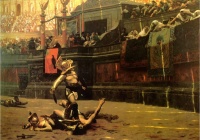Thumbs signal
From The Art and Popular Culture Encyclopedia
(Difference between revisions)
| Revision as of 17:31, 16 June 2008 Jahsonic (Talk | contribs) ← Previous diff |
Revision as of 21:26, 27 May 2011 Jahsonic (Talk | contribs) Next diff → |
||
| Line 1: | Line 1: | ||
| [[Image:Jean-Leon Gerome Pollice Verso.jpg|thumb|right|200px|''[[Pollice Verso]]'' by Jean-Léon Gérôme, 1872, is the immediate source of the "[[thumbs down]]" [[gesture]] in [[popular culture]]. It is owned by [[Phoenix Art Museum]].]] | [[Image:Jean-Leon Gerome Pollice Verso.jpg|thumb|right|200px|''[[Pollice Verso]]'' by Jean-Léon Gérôme, 1872, is the immediate source of the "[[thumbs down]]" [[gesture]] in [[popular culture]]. It is owned by [[Phoenix Art Museum]].]] | ||
| {{Template}} | {{Template}} | ||
| + | |||
| + | The [[Latin]] phrase ''[[pollice verso]]'' is used in the context of [[Gladiator|gladiatorial combat]] for a hand gesture used by [[Ancient Roman]] crowds to pass judgment on a defeated gladiator. However, the type of gesture described by the phrase ''pollice verso'' and its meaning are unclear in the historical and literary record. | ||
| + | |||
| + | In modern popular culture, it is assumed that "thumbs down" was the signal that a defeated gladiator should be condemned to [[death]]; "thumbs up", that he should be spared, a view popularized by a widely reproduced painting by the 19th-century artist [[Jean-Léon Gérôme]], whose ''Pollice Verso'' (usually known in English as "Thumbs Down") depicts a triumphant gladiator looking up into the stands for the verdict of the crowd. | ||
| + | |||
| {{GFDL}} | {{GFDL}} | ||
Revision as of 21:26, 27 May 2011

Pollice Verso by Jean-Léon Gérôme, 1872, is the immediate source of the "thumbs down" gesture in popular culture. It is owned by Phoenix Art Museum.
|
Related e |
|
Featured: |
The Latin phrase pollice verso is used in the context of gladiatorial combat for a hand gesture used by Ancient Roman crowds to pass judgment on a defeated gladiator. However, the type of gesture described by the phrase pollice verso and its meaning are unclear in the historical and literary record.
In modern popular culture, it is assumed that "thumbs down" was the signal that a defeated gladiator should be condemned to death; "thumbs up", that he should be spared, a view popularized by a widely reproduced painting by the 19th-century artist Jean-Léon Gérôme, whose Pollice Verso (usually known in English as "Thumbs Down") depicts a triumphant gladiator looking up into the stands for the verdict of the crowd.
Unless indicated otherwise, the text in this article is either based on Wikipedia article "Thumbs signal" or another language Wikipedia page thereof used under the terms of the GNU Free Documentation License; or on research by Jahsonic and friends. See Art and Popular Culture's copyright notice.

